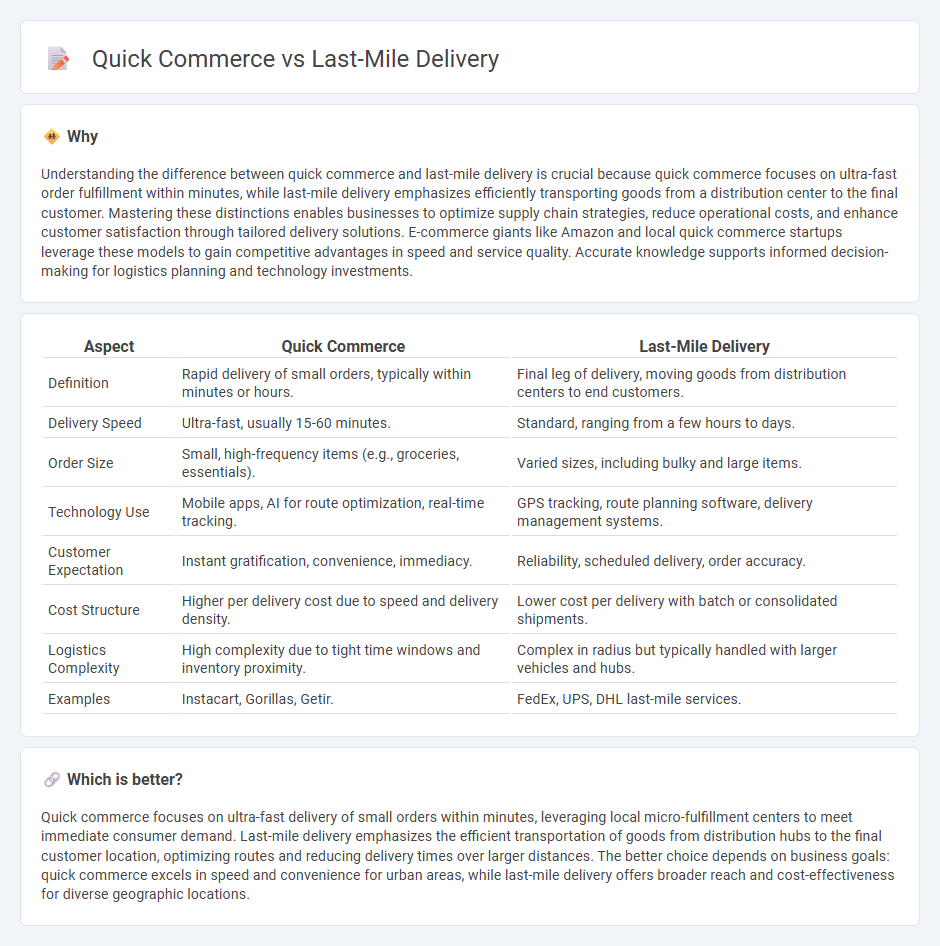
Quick commerce focuses on ultra-fast delivery of small orders, often within minutes, leveraging localized warehouses and advanced inventory management. Last-mile delivery represents the final step in the supply chain, ensuring efficient transportation from distribution centers to the customer's doorstep, crucial for customer satisfaction and retention. Explore the distinctions and innovations driving these logistics paradigms today.
Why it is important
Understanding the difference between quick commerce and last-mile delivery is crucial because quick commerce focuses on ultra-fast order fulfillment within minutes, while last-mile delivery emphasizes efficiently transporting goods from a distribution center to the final customer. Mastering these distinctions enables businesses to optimize supply chain strategies, reduce operational costs, and enhance customer satisfaction through tailored delivery solutions. E-commerce giants like Amazon and local quick commerce startups leverage these models to gain competitive advantages in speed and service quality. Accurate knowledge supports informed decision-making for logistics planning and technology investments.
Comparison Table
| Aspect | Quick Commerce | Last-Mile Delivery |
|---|---|---|
| Definition | Rapid delivery of small orders, typically within minutes or hours. | Final leg of delivery, moving goods from distribution centers to end customers. |
| Delivery Speed | Ultra-fast, usually 15-60 minutes. | Standard, ranging from a few hours to days. |
| Order Size | Small, high-frequency items (e.g., groceries, essentials). | Varied sizes, including bulky and large items. |
| Technology Use | Mobile apps, AI for route optimization, real-time tracking. | GPS tracking, route planning software, delivery management systems. |
| Customer Expectation | Instant gratification, convenience, immediacy. | Reliability, scheduled delivery, order accuracy. |
| Cost Structure | Higher per delivery cost due to speed and delivery density. | Lower cost per delivery with batch or consolidated shipments. |
| Logistics Complexity | High complexity due to tight time windows and inventory proximity. | Complex in radius but typically handled with larger vehicles and hubs. |
| Examples | Instacart, Gorillas, Getir. | FedEx, UPS, DHL last-mile services. |
Which is better?
Quick commerce focuses on ultra-fast delivery of small orders within minutes, leveraging local micro-fulfillment centers to meet immediate consumer demand. Last-mile delivery emphasizes the efficient transportation of goods from distribution hubs to the final customer location, optimizing routes and reducing delivery times over larger distances. The better choice depends on business goals: quick commerce excels in speed and convenience for urban areas, while last-mile delivery offers broader reach and cost-effectiveness for diverse geographic locations.
Connection
Quick commerce revolutionizes last-mile delivery by enabling ultra-fast order fulfillment through localized micro-fulfillment centers and real-time inventory tracking. Last-mile delivery leverages advanced route optimization algorithms and electric vehicles to reduce delivery times and carbon emissions, enhancing customer satisfaction. Integration of AI-driven demand forecasting and automated dispatch systems further streamlines the connection between quick commerce and efficient last-mile delivery operations.
Key Terms
Delivery Speed
Last-mile delivery emphasizes efficient transport of goods from distribution centers directly to customers, aiming to optimize route planning and minimize delivery time. Quick commerce accelerates this process by leveraging localized micro-fulfillment centers to offer delivery within minutes, often under 30 minutes. Explore the innovative strategies powering delivery speed advancements in both models.
Fulfillment Center
Last-mile delivery leverages strategically located fulfillment centers to minimize transit time and enhance customer satisfaction by ensuring faster order processing and dispatch. Quick commerce intensifies this approach with micro-fulfillment centers positioned within urban areas, enabling deliveries in under an hour by optimizing inventory and delivery logistics. Explore the evolving role of fulfillment centers in revolutionizing last-mile delivery and quick commerce efficiency.
Hyperlocal Distribution
Last-mile delivery emphasizes efficient final leg transport from local hubs to customers, reducing transit time and costs in the hyperlocal distribution network. Quick commerce (q-commerce) leverages ultra-fast delivery models, often promising orders within minutes by utilizing decentralized micro-fulfillment centers. Explore the evolving strategies shaping the future of hyperlocal distribution and consumer expectations.
Source and External Links
Last mile delivery: solutions for your business | DHL Discover - Last mile delivery, also known as final mile, is the last leg of the journey from local distribution centers to the consumer, focusing on affordability, speed, and accuracy with various transport methods including vans, bikes, and emerging technologies like drones and autonomous robots.
What is Last Mile Delivery? Everything You Need to Know - Onfleet - Last mile delivery is the critical final step of the delivery process where a parcel moves from a transportation hub to the end customer, involving key processes such as order digitization, sorting by routes, and timely delivery to match growing consumer demand for speed and efficiency.
Last Mile Delivery Explained: Trends, Challenges, Costs & More - The last mile is the final stage of the supply chain where items are sent from local warehouses to customers, playing a crucial role in customer experience and brand perception, especially important as eCommerce sales rise globally.
 dowidth.com
dowidth.com